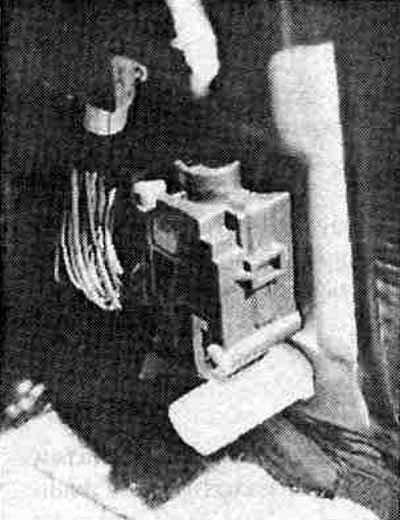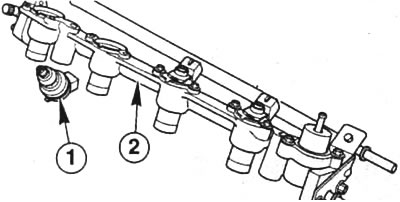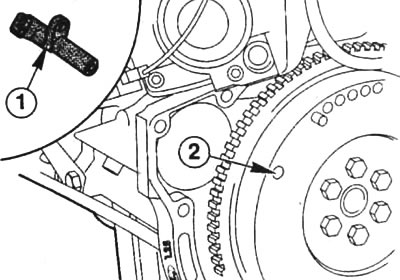Safety switch of the fuel injection system: in all Focus is located in the side wall in front of the passenger door next to the driver. The switch interrupts the fuel supply in the event of a leak in the fuel system, in the event of an accident or strong shaking. You will recognize a break in the electrical circuit by the pop-up switch button. To activate the safety switch, first check the fuel system for leaks, then turn the ignition switch to the «0» and then press the switch. Then turn the ignition switch to position for a few seconds «II» and finally to the position «I».

Fuel injection safety switch. Activates front right in the footwell.
Air quantity meter (MAF sensor): located in front of the throttle body - between the intake air noise damper and the intake hose - in the engine compartment. The hot-wire MAF flow meter operates on the principle of permanent superheat. In order to keep the difference in temperature with respect to the passing intake air constantly at the same level, it is continuously heated. The on-board computer determines the actual density of the fresh air sucked in based on the different heating energies. MAF sensor signals affect:
- the amount of injected fuel,
- moment of ignition
- idle air control valve (IAC),
- fuel vapor collection system (EVAP),
- underpressure control system (EGR),
- lambda adjustment.
Throttle position sensor (TP sensor): located directly on the throttle body. It works on the principle of a potentiometer. TP sensor signals affect:
- the amount of injected fuel,
- idle adjustment and shutdown of the forced idle mode,
- moment of ignition.
Injection valves: four-port side-feed injection valves are placed in a common fuel distributor tube.

Mounted together: Four-port injection valves 1 in Focus petrol engines are located in a common fuel rail 2
intake air temperature sensor (IAT sensor): located directly in the MAE housing IAT sensor signals act as correction values for:
- the amount of injected fuel,
- idle adjustment.
crankshaft position sensor (TFR sensor): in all engines, the Focus is located on the gearbox flange of the engine block. The sensor inductively registers the exact angle of the crankshaft position, as well as the number of engine revolutions at the moment. Its measurement values affect:
- quantity of injected fuel and injection timing,
- moment of ignition.
- idle adjustment.
Failure of the TFR sensor paralyzes all engine control: the engine stops and does not start until the sensor is replaced.

1 - SKR sensor; 2 - flywheel impulse sector
Camshaft position sensor (CMP sensor): located in the cylinder head in front of the first cam of the exhaust camshaft. The sensor works according to the inductive principle. It controls sequential fuel injection.
Its signal is used by the EEC-V-PCM to recognize the 1st cylinder. The base mark is the pulse cam of the exhaust camshaft.
Lambda probe (HO2S): located directly on the exhaust manifold. It informs the control unit about the current content of residual oxygen in the exhaust gases. To keep response time to a minimum (up to about 3 s), the probe is additionally heated electrically after each start of a cold engine. The lambda probe signal affects:
- the amount of injected fuel,
- operation of the fuel vapor recovery system (EVAP).
The lambda probe has a strong influence on the function and life of the catalytic converter. Its perfect operation depends on the constant change between a slightly rich and slightly lean air-fuel mixture.
Pneumatic pressure switch servo control (PSP): located in the pressure line of the hydraulic servo control (on the right in the engine compartment). When at rest, the switch is closed; it only opens at the specified pressure in the hydraulic system. Its signal is evaluated by the EEC-V-PCM control unit in order to increase the idle speed if necessary. The PSP switch affects:
- idling (idle air control valve),
- the amount of injected fuel,
- moment of ignition.
Speed sensor (VSS): located in the gearbox housing. The VSS sensor works according to the Hall principle. Its signals affect:
- increase in idle speed in a rolling car,
- disabling the forced idle mode when driving downhill.
Visitor comments